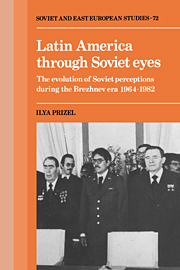 Latin America through Soviet Eyes
Latin America through Soviet Eyes Book contents
- Frontmatter
- Contents
- Preface
- Acknowledgments
- Introduction
- Part I Soviet perceptions of Latin America's global role
- Introduction
- 1 Soviet perceptions of US–Latin American relations
- 2 Latin America's role in the capitalist division of labor
- 3 Latin America's role in the Third World
- 4 Soviet views on Latin America's regional integration
- 5 Soviet conclusions regarding Latin America's ability to conduct an independent foreign policy
- Part II Soviet perceptions of Latin American social structures
- Part III Soviet–Latin American relations during the Brezhnev era
- Part IV Conclusion: the emerging Soviet perception of Latin America and the future of Soviet policy toward the hemisphere
- Conclusions
- Epilogue – Latin America: the Long March
- Notes
- Bibliography
- Index
1 - Soviet perceptions of US–Latin American relations
Published online by Cambridge University Press: 05 February 2012
- Frontmatter
- Contents
- Preface
- Acknowledgments
- Introduction
- Part I Soviet perceptions of Latin America's global role
- Introduction
- 1 Soviet perceptions of US–Latin American relations
- 2 Latin America's role in the capitalist division of labor
- 3 Latin America's role in the Third World
- 4 Soviet views on Latin America's regional integration
- 5 Soviet conclusions regarding Latin America's ability to conduct an independent foreign policy
- Part II Soviet perceptions of Latin American social structures
- Part III Soviet–Latin American relations during the Brezhnev era
- Part IV Conclusion: the emerging Soviet perception of Latin America and the future of Soviet policy toward the hemisphere
- Conclusions
- Epilogue – Latin America: the Long March
- Notes
- Bibliography
- Index
Summary
Pre-détente (1964–69)
Given that the cornerstone of Soviet foreign policy was to avoid direct confrontation with the United States, especially in an area as remote and marginal to the USSR as Latin America, the Brezhnev era began at a rather inauspicious moment for Soviet interests in the region. Gone was the euphoric perception of the early 1960s that the Latin American continent was ripe for a shift from the capitalist path of development. It had been less than two years since the Cuban missile crisis, and the Johnson administration had quickly made clear that it was ready to defend US interests in the region by all the means at its disposal. Yet Soviet policymakers were being pressured by China and Cuba, which relentlessly browbeat Moscow over its failure to fulfill its internationalist duty by supporting “wars of national liberation” throughout Latin America.
Thus, during the pre-détente era Soviet policy followed two some what contradictory tracks. On the one hand, Moscow attempted to preserve its fragile détente with China (1964–65) and, more important, its influence in the radicalized Third World, by supporting wars of national liberation in Latin America, albeit most modestly and discreetly. On the other hand, Moscow carefully studied Washington's policy toward and position in Latin America so as not to overstep the limits of US tolerance of Soviet activity in the United States' backyard.
- Type
- Chapter
- Information
- Latin America through Soviet EyesThe Evolution of Soviet Perceptions during the Brezhnev Era 1964–1982, pp. 9 - 39Publisher: Cambridge University PressPrint publication year: 1990
